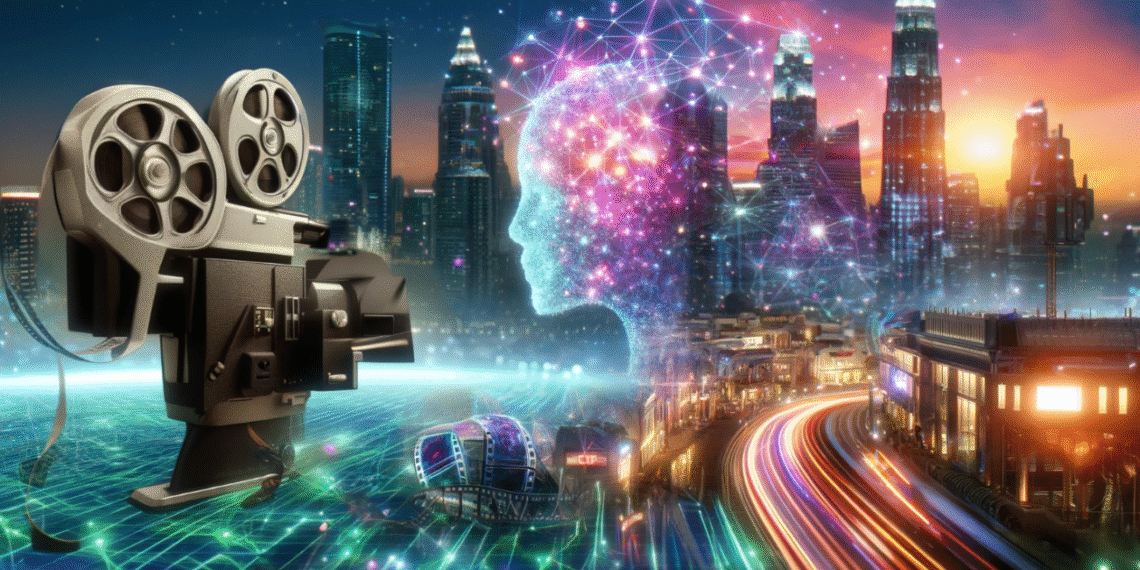Virtual Reality: Transforming the Cinematic Experience
Virtual reality (VR) is poised to revolutionize how we experience movies, offering immersive and interactive narratives that go beyond traditional cinema’s limitations. By placing viewers directly within the story, VR creates a sense of presence and engagement previously unattainable.
1. Immersive Storytelling
VR films provide a 360-degree view, allowing viewers to explore the environment and interact with the story in a way that traditional cinema cannot. This level of immersion enhances emotional connection and creates a more memorable viewing experience. Imagine walking alongside your favorite characters, influencing the plot, and feeling truly present in the film’s world. This shift from passive observer to active participant is a game-changer for cinematic storytelling.
2. Interactive Narratives
Unlike traditional films, VR allows for interactive narratives, where viewers can make choices that affect the story’s outcome. This branching narrative structure creates a personalized experience, with each viewer potentially experiencing a unique version of the film. The level of engagement is significantly higher, as the audience becomes an active contributor to the unfolding story, blurring the lines between viewer and character.
3. Enhanced Emotional Impact
The immersive nature of VR intensifies emotional responses. By placing viewers directly within the scene, VR films can evoke stronger feelings of empathy, fear, joy, and sadness. The enhanced sensory experience amplifies the impact of the narrative, creating a powerful and lasting impression. This ability to elicit deeper emotional connections makes VR a potent tool for storytelling.
4. Challenges and Opportunities
Despite its potential, VR cinema faces challenges, including technological limitations, high production costs, and the need for specialized equipment. However, advancements in VR technology, coupled with increasing accessibility, are paving the way for wider adoption. The opportunities for innovation in storytelling are vast, and as the technology matures, VR is poised to become an integral part of the future of film.
Artificial Intelligence: Revolutionizing Film Production and Creativity
AI is rapidly changing filmmaking, offering new tools for efficiency, creativity, and audience engagement. Its impact spans from pre-production to post-production, reshaping how stories are told and experienced.
| Application | Description | Projected Growth (2024-2025) | Key Benefit |
|---|---|---|---|
| Scriptwriting | AI assists in generating ideas, refining dialogue, and analyzing script performance. | 25% increase in usage | Faster script development |
| Visual Effects (VFX) | AI automates complex VFX tasks, reducing time and costs. | 30% reduction in VFX costs | Increased efficiency and realism |
| Film Editing | AI algorithms analyze footage and suggest edits, speeding up the editing process. | 20% faster editing workflows | Improved storytelling and pacing |
| Personalized Content | AI analyzes viewer data to create customized trailers and recommendations. | 15% increase in engagement | Enhanced audience experience and retention |
1. AI-Assisted Scriptwriting
AI is becoming a valuable tool for screenwriters. It can analyze existing scripts to identify successful tropes and patterns, generate story ideas based on specific parameters, and even assist with dialogue writing. While AI can’t replace human creativity entirely, it can serve as a powerful brainstorming partner, helping writers overcome writer’s block and explore new narrative possibilities. This technology allows for faster script development and more data-driven decisions in the early stages of filmmaking, potentially leading to more engaging and commercially successful films.
2. Streamlining Visual Effects (VFX)
The creation of visual effects is traditionally a time-consuming and expensive process. AI is now automating many aspects of VFX, such as rotoscoping, motion tracking, and compositing. AI-powered tools can significantly reduce the time and cost associated with these tasks, allowing filmmakers to achieve stunning visual effects with greater efficiency. This democratization of VFX technology opens up new possibilities for independent filmmakers and smaller studios, enabling them to compete with larger productions.
3. Revolutionizing Film Editing
AI algorithms can analyze vast amounts of footage and identify key scenes, suggest edits, and even create rough cuts. This technology can dramatically speed up the editing process, allowing editors to focus on the more creative aspects of their work, such as pacing and storytelling. AI can also help editors identify and correct errors, such as continuity mistakes, ensuring a polished and professional final product. The use of AI in editing is not about replacing human editors but rather augmenting their abilities and streamlining their workflows.
Interactive Storytelling: Engaging Audiences in New Dimensions
Interactive storytelling is revolutionizing how we experience film, moving beyond passive viewership to active participation. This shift offers unprecedented opportunities for audience engagement and narrative exploration.
1. Branching Narratives and Choices
Branching narratives are a core element of interactive storytelling. Viewers make choices that directly impact the plot, character development, and ending. This creates a personalized viewing experience, as each individual’s decisions lead to a unique storyline. Platforms increasingly offer tools for filmmakers to easily create and manage these complex narrative structures, making interactive film more accessible to independent creators.
2. Virtual Reality (VR) and Augmented Reality (AR) Integration
VR and AR technologies immerse audiences directly into the film’s world. Viewers can explore environments, interact with characters, and even influence events through their actions within the virtual or augmented space. This level of immersion fosters a deeper emotional connection with the story and its characters.
3. Gamification and Interactive Elements
Gamification techniques, such as puzzles, challenges, and reward systems, can be integrated into films to enhance engagement. Viewers might need to solve a riddle to unlock a scene or complete a task to help a character progress. This active participation transforms the viewing experience into a collaborative game, blurring the lines between film and interactive entertainment.
4. Live Performances and Real-Time Interaction
Some interactive films incorporate live performances or real-time interaction with actors. Viewers can communicate with characters through chat or video calls, influencing their actions and shaping the story as it unfolds live. This adds an element of unpredictability and excitement, making each viewing a unique and unrepeatable experience.
Streaming Platforms and Their Role in Immersive Cinema
Streaming platforms are reshaping how we experience movies, offering new avenues for immersive storytelling and interactive experiences. They are no longer just distributors but active participants in cinematic innovation.
1. Expanding Accessibility of Immersive Technologies
Streaming platforms are democratizing access to immersive cinema by making it available on devices people already own, like smartphones and smart TVs. This bypasses the need for expensive equipment such as dedicated VR headsets, lowering the barrier to entry for a wider audience. The integration of spatial audio technologies further enhances the viewing experience on standard devices, creating a more enveloping soundscape. This increased accessibility allows filmmakers to experiment with immersive techniques without being limited by niche hardware requirements.
2. Interactive Storytelling and User Engagement
Streaming platforms are pioneering interactive storytelling formats that blur the lines between viewer and participant. Shows like “Black Mirror: Bandersnatch” on Netflix allow viewers to make choices that directly impact the narrative, leading to multiple endings and personalized experiences. This interactive approach fosters a deeper sense of engagement and investment in the story, transforming the viewing experience from passive consumption to active participation. The data collected from these interactive narratives can also provide valuable insights for filmmakers, allowing them to tailor future content to audience preferences.
3. Experimentation with VR and AR Integration
While widespread adoption is still in its early stages, streaming platforms are exploring the potential of virtual reality (VR) and augmented reality (AR) to enhance the cinematic experience. Disney+, for example, has experimented with AR filters that allow viewers to interact with characters and objects from their favorite movies. Furthermore, adaptations of popular franchises into VR experiences, such as “Star Wars: Tales from the Galaxy’s Edge,” offer viewers the opportunity to step into the world of the film and interact with it in a more immersive way. These experiments are paving the way for future integrations of VR and AR technologies into mainstream streaming content.
Q&A
Question 1: What are the key differences between traditional cinema and virtual reality (VR) cinema in terms of viewer experience and storytelling?
Answer: Traditional cinema offers a passive viewing experience with a fixed camera angle and linear storytelling. VR cinema, conversely, allows for active participation, user-controlled viewpoints, high immersion levels, interactive narratives with branching storylines, and a shift from passive observer to active participant.
Question 2: What are some examples of how interactive storytelling is enhancing audience engagement in film?
Answer: Interactive storytelling uses branching narratives where viewer choices impact the plot, VR/AR integration to immerse viewers in the film’s world, gamification elements like puzzles and challenges, and live performances with real-time interaction to create unique and personalized experiences. This active participation significantly increases engagement compared to passive viewing.
Question 3: How are streaming platforms contributing to the growth and accessibility of immersive cinema?
Answer: Streaming platforms are expanding accessibility by offering immersive content on readily available devices (smartphones, smart TVs), integrating spatial audio, and pioneering interactive storytelling formats like “choose-your-own-adventure” narratives. They are also experimenting with VR and AR integrations, although widespread adoption is still in its early stages.






